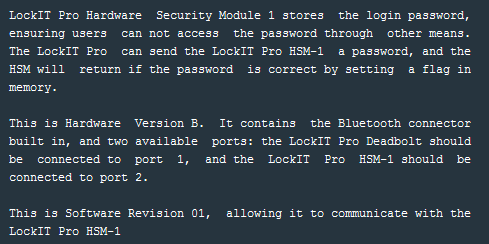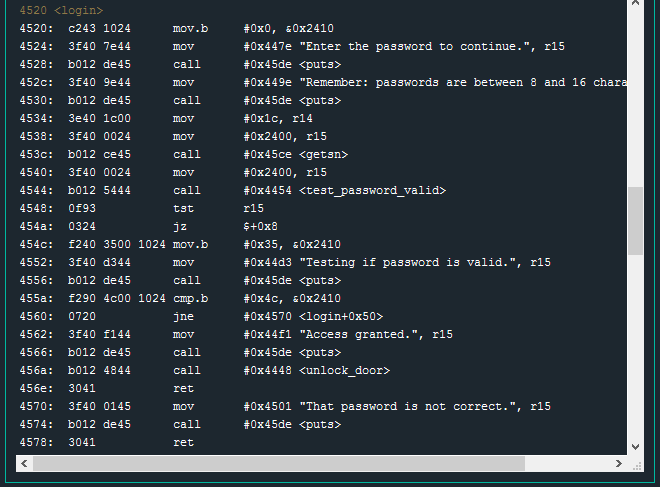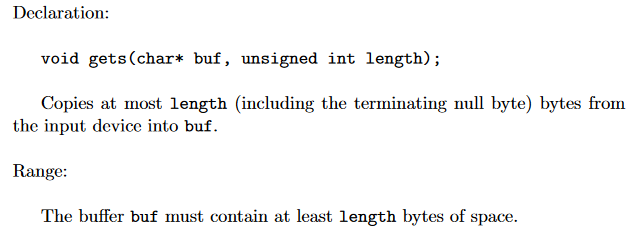Micro Corruption - 03 - Hanoi
by
This is level 3 of the Micro Corruption CTF.
Note: This level highlighted an important lesson for me personally. I often make things too complicated and jump to the most sophisticated solution too quickly. I jump to conclusions. With a little more patience and just a little more time reviewing the big picture, this level would have been a much quicker solve. WORK SMART NOT HARD!!
On the previous two revisions of the LockIT Pro – the password was available for extraction directly from the debugger. For a walk-through of level 2 - Sydney, click here
According to the latest update, the new lock revision b.01 employs a separate hardware security module (HSM) which will store the password separate from the lock firmware. In theory, the HSM contents will not be directly accessible from the debugger.
Scrolling through the debugger, it looks like the main function simply makes a call to login. So I will examine the login function to get an idea of how this lock will operate.
As with previous locks, we see some preliminary call puts operations to display prompts to the user. Previous locks used a get_password function to get user input, but this lock employs calls to getsn. The lock manual (provided with the debugger) has this to say about the gets function:
The function takes two arguments - an address pointer to a buffer in memory and an integer specifying the number of bytes to read from the input device.
Looking at the two instructions just before call getsn, we can see what the values for these arguments are:
4534: 3e40 1c00 mov #0x1c, r14
4538: 3f40 0024 mov #0x2400, r15
453c: b012 ce45 call #0x45ce <getsn>
The function declaration, as shown in the documentation, shows the first argument is a pointer to a buffer. In the debugger, working backwards from the call operation, this argument is: mov #0x2400, r15. The input specified by the user will be placed in memory at address 0x2400.
Continuing on to the second argument - the length of the input to copy - mov #0x1c, r14. The length is 0x1c bytes(hex) or 28 bytes(decimal). This is interesting.
According to the user prompt a few instructions earlier:
452c: 3f40 9e44 mov #0x449e "Remember: passwords are between 8 and 16 characters.", r15
Passwords are not expected to be any larger than than 16 characters (bytes), but the getsn function will read in up to 28 bytes (only stopping if a null byte - 0x00 - is encountered in the input ). If the firmware is only expecting 16 characters, but we can input 28 there may be an opportunity for a buffer overflow.
Before I take a deep dive in debugging specifics, I want to first see what normal looks like. The prompt says passwords should be between 8 and 16 characters. I will run the program and submit a string of 12 characters and observe the result.
Test password: TWELVECHARS!
As expected, the string “TWELVECHARS!” is not the correct password and the lock exited normally.
Next, I will reset the lock and try a string of 18 characters - two more than expected.
Test password: EIGHTEENCHARACTERS
Even with two extra characters the program exits normally. Let’s try the full 28 characters and see what happens.
Test password: TWENTYEIGHTCHARACTERPASSWORDAA
Even with 28 characters there was no abnormal functionality. This is where my initial investigation went off the rails. As soon as I saw buffer overflow could be an option, I had assumed the overflow would overwrite a return address somewhere which would lead to a program crash. Analyzing the crash, I thought I would be able to control execution and solve this level with custom shellcode. I spent a lot of time trying to figure out why my 28 byte input wasn’t crashing the lock.
As it turns out - I was overthinking this problem by a mile.
Taking another look at the login function and at the I/O console output - I noticed something interesting.
The string “Testing if password is valid” is only output to the console after the call to the test_password_valid function. Why?
Directly after the string “Testing if password is valid” is output to the screen, we see a cmp.b operation.
455a: f290 4c00 1024 cmp.b #0x4c, &0x2410
4560: 0720 jne #0x4570 <login+0x50>
This is checking if the byte found at address 0x2410 is equal to 0x4c or capital L (ascii). The next operation will jump to offset 0x50 in the login function if the comparison is NOT equal (Password is not correct).
If the result of the comparison is equal - we will get an “Access Granted” message and the unlock_door function will be called.
4562: 3f40 f144 mov #0x44f1 "Access granted.", r15
4566: b012 de45 call #0x45de <puts>
456a: b012 4844 call #0x4448 <unlock_door>
User input is saved at offset 0x2400 on the stack. The software expects the password to be at most 16 characters long which would take up memory from 0x2400 - 0x240F. The very next byte, 0x2410, is a flag value set by Hardware Security Module (HSM) 1. If the correct password is entered, HSM 1 sets this flag to capital “L”.
Since password input is stored at 0x2400, and I can input more than 16 characters, I can control what byte ends up at position 0x2410.
0x2410 is 17 bytes in to the input buffer. I will use a password such that the 17th character is capital L.
Test password: SEVENTEENTHCHRISL
Success! With this password we get the satisfying door unlocked message.






